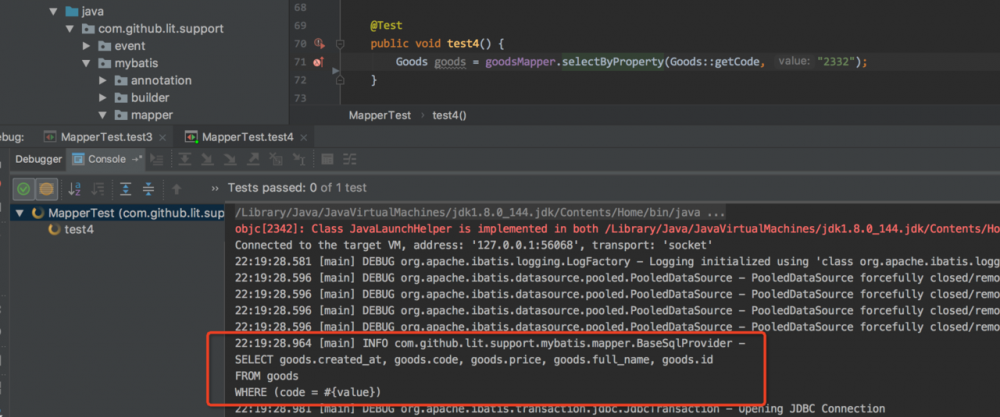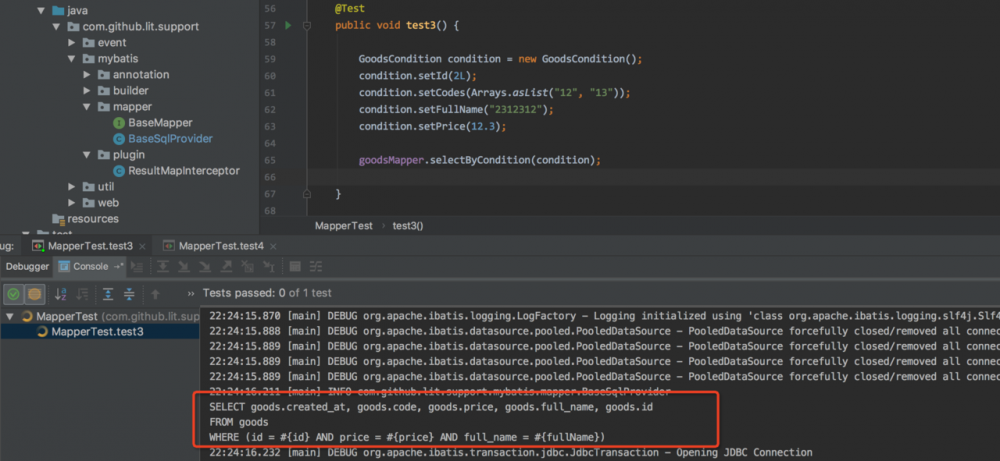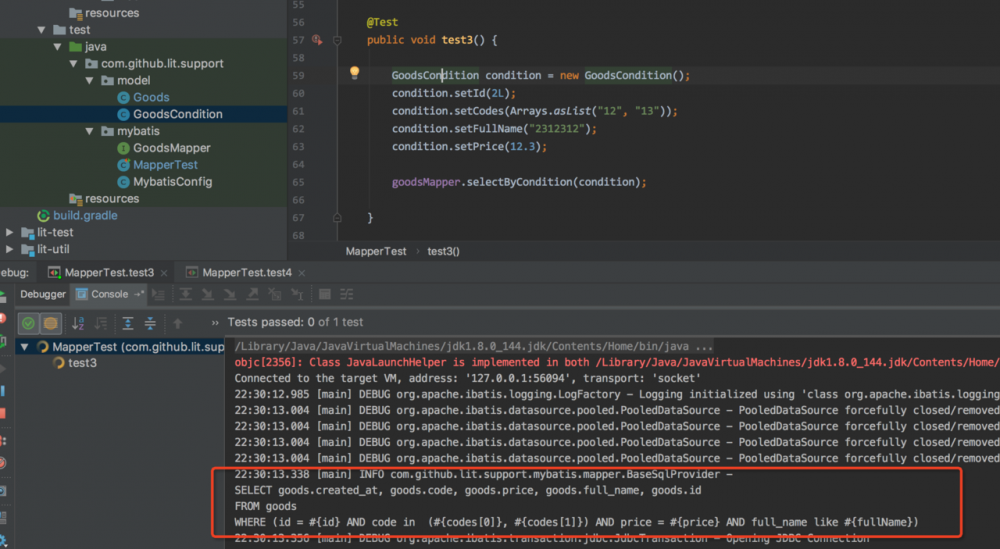Mybatis通用mapper和动态ResultMap的设计和实现
前言
之前公司用的jpa, 个人感觉很方便, 新的项目选择使用mybatis, sql都是写在xml文件里, 虽然基本的方法都有工具生成, 但是一旦数据增加一个字段, 修改这些方法真的是不爽, 而且个人看xml文件感觉是真的累, 就这样不爽里一段时间, 趁着项目空闲的时候, 研究下如何抛弃xml文件, 完全使用注解的方式, 并且把通用的方法抽出到一个基类中。
本文代码已整理上传 github
如何实现BaseMapper<T>
通用mapper一般包含基本的增删改, 根据id查, 根据某一个属性查, 根据条件集合查 这些方法。 使用的时候直接继承, 泛型就是具体的实体类。 mybatis 提供了@InsertProvider, @SelectProvider等来动态生成sql, 所以通用mapper就是使用的这些注解。
通用mapper动态生成sql的思路就是拿到实体类的class, 根据class解析出对应表的元数据, 包括表名, 主键信息, 数据库字段等, 在根据这些信息动态生成sql。
对于insert和update来说, 方法的参数就是实体对象, 直接getClass()就能拿到, 但是对于查询和删除,方法的参数就不是实体对象了, 在通用mapper里怎么拿到 class对象 , mybatis 3.4.5 之前的版本是做不到的, 从源码里就限制了, 参考 mybatis的这个issue , 3.4.5版本开始, 在调用provider方法时 可以多传递一个参数-ProviderContext, 这个ProviderContext 就可以获取当前具体是哪个mapper的class和调用的方法。
这样通过 具体mapper的接口获取到泛型参数, 这个泛型参数就是实体对象, 就是 T 的具体值 下面是具体的实现, 使用mybatis的版本是 3.4.6, 依赖了 spring的一些工具类
BaseMapper<Entity>.java
public interface BaseMapper<Entity> {
/**
* 新增一条记录
*
* @param entity 实体
* @return 受影响记录
*/
@InsertProvider(type = BaseSqlProvider.class, method = "insert")
@Options(useGeneratedKeys = true, keyColumn = "id")
int insert(Entity entity);
/**
* 更新一条记录
*
* @param entity entity
* @return 受影响记录
*/
@UpdateProvider(type = BaseSqlProvider.class, method = "update")
int update(Entity entity);
/**
* 删除一条记录
*
* @param id id
* @return 受影响记录
*/
@DeleteProvider(type = BaseSqlProvider.class, method = "delete")
int delete(Long id);
/**
* 根据id查询
*
* @param id id
* @return Entity
*/
@SelectProvider(type = BaseSqlProvider.class, method = "selectById")
Entity selectById(Long id);
/**
* 根据属性查询一条记录
*
* @param function property
* @param value value
* @param <R> R
* @return Entity
*/
@SelectProvider(type = BaseSqlProvider.class, method = "selectByProperty")
<R> Entity selectByProperty(@Param("property") PropertyFunction<Entity, R> function, @Param("value") Object value);
/**
* 根据属性查询记录列表
*
* @param function property
* @param value value
* @param <R> R
* @return Entity
*/
@SelectProvider(type = BaseSqlProvider.class, method = "selectByProperty")
<R> List<Entity> selectListByProperty(@Param("property") PropertyFunction<Entity, R> function, @Param("value") Object value);
/**
* 根据查询条件查询记录
*
* @param condition condition
* @param <Condition> Condition
* @return List Entity
*/
@SelectProvider(type = BaseSqlProvider.class, method = "selectByCondition")
<Condition> List<Entity> selectByCondition(Condition condition);
}
复制代码
BaseSqlProvider.java
public class BaseSqlProvider {
public <Entity> String insert(Entity entity) {
Assert.notNull(entity, "entity must not null");
Class<?> entityClass = entity.getClass();
TableMataDate mataDate = TableMataDate.forClass(entityClass);
Map<String, String> fieldColumnMap = mataDate.getFieldColumnMap();
SQL sql = new SQL();
sql.INSERT_INTO(mataDate.getTableName());
for (Map.Entry<String, String> entry : fieldColumnMap.entrySet()) {
// 忽略主键
if (Objects.equals(entry.getKey(), mataDate.getPkProperty())) {
continue;
}
PropertyDescriptor ps = BeanUtils.getPropertyDescriptor(entityClass, entry.getKey());
if (ps == null || ps.getReadMethod() == null) {
continue;
}
Object value = ReflectionUtils.invokeMethod(ps.getReadMethod(), entity);
if (!StringUtils.isEmpty(value)) {
sql.VALUES(entry.getValue(), getTokenParam(entry.getKey()));
}
}
return sql.toString();
}
public <Entity> String update(Entity entity) {
Assert.notNull(entity, "entity must not null");
Class<?> entityClass = entity.getClass();
TableMataDate mataDate = TableMataDate.forClass(entityClass);
Map<String, String> fieldColumnMap = mataDate.getFieldColumnMap();
SQL sql = new SQL();
sql.UPDATE(mataDate.getTableName());
for (Map.Entry<String, String> entry : fieldColumnMap.entrySet()) {
// 忽略主键
if (Objects.equals(entry.getKey(), mataDate.getPkProperty())) {
continue;
}
PropertyDescriptor ps = BeanUtils.getPropertyDescriptor(entityClass, entry.getKey());
if (ps == null || ps.getReadMethod() == null) {
continue;
}
Object value = ReflectionUtils.invokeMethod(ps.getReadMethod(), entity);
if (!StringUtils.isEmpty(value)) {
sql.SET(getEquals(entry.getValue(), entry.getKey()));
}
}
return sql.WHERE(getEquals(mataDate.getPkColumn(), mataDate.getPkProperty())).toString();
}
public String delete(ProviderContext context) {
Class<?> entityClass = getEntityClass(context);
TableMataDate mataDate = TableMataDate.forClass(entityClass);
return new SQL().DELETE_FROM(mataDate.getTableName())
.WHERE(getEquals(mataDate.getPkColumn(), mataDate.getPkProperty()))
.toString();
}
public String selectById(ProviderContext context) {
Class<?> entityClass = getEntityClass(context);
TableMataDate mataDate = TableMataDate.forClass(entityClass);
return new SQL().SELECT(mataDate.getBaseColumns())
.FROM(mataDate.getTableName())
.WHERE(getEquals(mataDate.getPkColumn(), mataDate.getPkProperty()))
.toString();
}
public String selectByProperty(ProviderContext context, Map<String, Object> params) {
PropertyFunction propertyFunction = (PropertyFunction) params.get("property");
String property = SerializedLambdaUtils.getProperty(propertyFunction);
Class<?> entityClass = getEntityClass(context);
TableMataDate mataDate = TableMataDate.forClass(entityClass);
String column = mataDate.getFieldColumnMap().get(property);
return new SQL().SELECT(mataDate.getBaseColumns())
.FROM(mataDate.getTableName())
.WHERE(getEquals(column, property))
.toString();
}
public String selectByCondition(ProviderContext context, Object condition) {
Class<?> entityClass = getEntityClass(context);
TableMataDate mataDate = TableMataDate.forClass(entityClass);
Map<String, String> fieldColumnMap = mataDate.getFieldColumnMap();
SQL sql = new SQL().SELECT(mataDate.getBaseColumns()).FROM(mataDate.getTableName());
Field[] fields = condition.getClass().getDeclaredFields();
for (Field field : fields) {
Condition logicCondition = field.getAnnotation(Condition.class);
String mappedProperty = logicCondition == null || StringUtils.isEmpty(logicCondition.property()) ? field.getName() : logicCondition.property();
PropertyDescriptor entityPd = BeanUtils.getPropertyDescriptor(entityClass, mappedProperty);
if (entityPd == null) {
continue;
}
PropertyDescriptor pd = BeanUtils.getPropertyDescriptor(condition.getClass(), field.getName());
if (pd == null || pd.getReadMethod() == null) {
continue;
}
String column = fieldColumnMap.get(mappedProperty);
Object value = ReflectionUtils.invokeMethod(pd.getReadMethod(), condition);
if (!StringUtils.isEmpty(value)) {
Logic logic = logicCondition == null ? Logic.EQ : logicCondition.logic();
if (logic == Logic.IN || logic == Logic.NOT_IN) {
if (value instanceof Collection) {
sql.WHERE(column + logic.getCode() + inExpression(field.getName(), ((Collection) value).size()));
}
} else if (logic == Logic.NULL || logic == Logic.NOT_NULL) {
sql.WHERE(column + logic.getCode());
} else {
sql.WHERE(column + logic.getCode() + getTokenParam(mappedProperty));
}
}
}
return sql.toString();
}
private Class<?> getEntityClass(ProviderContext context) {
Class<?> mapperType = context.getMapperType();
for (Type parent : mapperType.getGenericInterfaces()) {
ResolvableType parentType = ResolvableType.forType(parent);
if (parentType.getRawClass() == BaseMapper.class) {
return parentType.getGeneric(0).getRawClass();
}
}
return null;
}
private String getEquals(String column, String property) {
return column + " = " + getTokenParam(property);
}
private String getTokenParam(String property) {
return "#{" + property + "}";
}
private String inExpression(String property, int size) {
MessageFormat messageFormat = new MessageFormat("#'{'" + property + "[{0}]}");
StringBuilder sb = new StringBuilder(" (");
for (int i = 0; i < size; i++) {
sb.append(messageFormat.format(new Object[]{i}));
if (i != size - 1) {
sb.append(", ");
}
}
return sb.append(")").toString();
}
}
复制代码
其他一些类
@Getter
public class TableMataDate {
private static final Map<Class<?>, TableMataDate> TABLE_CACHE = new ConcurrentHashMap<>(64);
/**
* 表名
*/
private String tableName;
/**
* 主键属性名
*/
private String pkProperty;
/**
* 主键对应的列名
*/
private String pkColumn;
/**
* 属性名和字段名映射关系的 map
*/
private Map<String, String> fieldColumnMap;
/**
* 字段类型
*/
private Map<String, Class<?>> fieldTypeMap;
private TableMataDate(Class<?> clazz) {
fieldColumnMap = new HashMap<>();
fieldTypeMap = new HashMap<>();
initTableInfo(clazz);
}
public static TableMataDate forClass(Class<?> entityClass) {
TableMataDate tableMataDate = TABLE_CACHE.get(entityClass);
if (tableMataDate == null) {
tableMataDate = new TableMataDate(entityClass);
TABLE_CACHE.put(entityClass, tableMataDate);
}
return tableMataDate;
}
public String getBaseColumns() {
Collection<String> columns = fieldColumnMap.values();
if (CollectionUtils.isEmpty(columns)) {
return "";
}
Iterator<String> iterator = columns.iterator();
StringBuilder sb = new StringBuilder();
while (iterator.hasNext()) {
String next = iterator.next();
sb.append(tableName).append(".").append(next);
if (iterator.hasNext()) {
sb.append(", ");
}
}
return sb.toString();
}
/**
* 根据注解初始化表信息,
*
* @param clazz 实体类的 class
*/
private void initTableInfo(Class<?> clazz) {
tableName = clazz.isAnnotationPresent(Table.class) ? clazz.getAnnotation(Table.class).name()
: NameUtils.getUnderLineName(clazz.getSimpleName());
Field[] fields = clazz.getDeclaredFields();
for (Field field : fields) {
// 过滤静态字段和有 @Transient 注解的字段
if (Modifier.isStatic(field.getModifiers()) ||
field.isAnnotationPresent(Transient.class) ||
!BeanUtils.isSimpleValueType(field.getType())) {
continue;
}
String property = field.getName();
Column column = field.getAnnotation(Column.class);
String columnName = column != null ? column.name().toLowerCase() : NameUtils.getUnderLineName(property);
// 主键信息 : 有 @Id 注解的字段,没有默认是 类名+Id
if (field.isAnnotationPresent(Id.class) || (property.equalsIgnoreCase("id") && pkProperty == null)) {
pkProperty = property;
pkColumn = columnName;
}
// 将字段对应的列放到 map 中
PropertyDescriptor descriptor = BeanUtils.getPropertyDescriptor(clazz, property);
if (descriptor != null && descriptor.getReadMethod() != null && descriptor.getWriteMethod() != null) {
fieldColumnMap.put(property, columnName);
fieldTypeMap.put(property, field.getType());
}
}
}
}
复制代码
数据库字段和实体属性不一致也是下划线转驼峰怎么办
在上面生成动态sql的时候在实体上可以加 @Column, @Table, @Id 注解保证生成的sql没问题 但是 对于查来说, 查出来后还要转成实体类的, 如果属性不对应, 转出来的实体就会缺少值, mybatis还提供类@Results注解写在方法上, 来自定义实体属性和数据库字段的映射,
但是都已经在实体类上写上@Column表示映射关系来,再在方法上写注解,很不雅观, 所以我们需要 动态生成ResultMap
mybatis里的接口方法 最终都会生成 MappedStaement 与之对应, 数据库字段和实体属性映射的信息也是保存在这里的, 所以只需要修改 MappedStaement 里的信息就可以了,
MappedStaement可以通过mybatis 自带的拦截机制, 拦截 Executor 的 query 方法获取
代码如下 已整理上传 github :
@Intercepts({
@Signature(type = Executor.class, method = "query", args = {MappedStatement.class, Object.class, RowBounds.class, ResultHandler.class}),
@Signature(type = Executor.class, method = "query", args = {MappedStatement.class, Object.class, RowBounds.class, ResultHandler.class, CacheKey.class, BoundSql.class}),
})
public class ResultMapInterceptor implements Interceptor {
@Override
public Object intercept(Invocation invocation) throws Throwable {
if (!(invocation.getTarget() instanceof Executor)) {
return invocation.proceed();
}
MappedStatement ms = (MappedStatement) invocation.getArgs()[0];
// xml sql 不做处理
if (ms.getResource().contains(".xml")) {
return invocation.proceed();
}
ResultMap resultMap = ms.getResultMaps().iterator().next();
if (!CollectionUtils.isEmpty(resultMap.getResultMappings())) {
return invocation.proceed();
}
Class<?> mapType = resultMap.getType();
if (ClassUtils.isAssignable(mapType, Collection.class)) {
return invocation.proceed();
}
TableMataDate mataDate = TableMataDate.forClass(mapType);
Map<String, Class<?>> fieldTypeMap = mataDate.getFieldTypeMap();
//
List<ResultMapping> resultMappings = new ArrayList<>(fieldTypeMap.size());
for (Map.Entry<String, String> entry : mataDate.getFieldColumnMap().entrySet()) {
ResultMapping resultMapping = new ResultMapping.Builder(ms.getConfiguration(), entry.getKey(), entry.getValue(), fieldTypeMap.get(entry.getKey())).build();
resultMappings.add(resultMapping);
}
ResultMap newRm = new ResultMap.Builder(ms.getConfiguration(), resultMap.getId(), mapType, resultMappings).build();
Field field = ReflectionUtils.findField(MappedStatement.class, "resultMaps");
ReflectionUtils.makeAccessible(field);
ReflectionUtils.setField(field, ms, Collections.singletonList(newRm));
return invocation.proceed();
}
@Override
public Object plugin(Object target) {
return Plugin.wrap(target, this);
}
@Override
public void setProperties(Properties properties) {
}
}
复制代码
使用效果
新建 GoodsMapper 继承 BaseMapper
public interface GoodsMapper extends BaseMapper<Goods> {
}
复制代码
@Data
public class Goods implements Serializable {
private static final long serialVersionUID = -6305173237589282633L;
private Long id;
private String code;
private String fullName;
private Double price;
private Date createdAt;
}
复制代码
查询
根据实体某个属性查询, eg: 根据商品 code 查询一条商品记录:
@Test
public void test4() {
Goods goods = goodsMapper.selectByProperty(Goods::getCode, "2332");
}
复制代码

根据查询条件查询*
新建商品的查询条件 GoodCondition
@Data
public class GoodsCondition implements Serializable {
private static final long serialVersionUID = -1113673119261537637L;
private Long id;
// @Condition(logic = Logic.IN, property = "code")
private List<String> codes;
private Double price;
// @Condition(logic = Logic.LIKE)
private String fullName;
private String code;
}
复制代码
使用 通用mapper的 selectByCondition 方法查询
@Test
public void test3() {
GoodsCondition condition = new GoodsCondition();
condition.setId(2L);
condition.setCodes(Arrays.asList("12", "13"));
condition.setFullName("2312312");
condition.setPrice(12.3);
goodsMapper.selectByCondition(condition);
}
复制代码

默认是以实体中存在的属性且值不为空作为查询条件, 默认是 = 条件, 所以condition 中 codes 虽然有值, 但是实体中没这个属性, 所以不作为查询条件, 可以加 @Condition 注解改变默认条件 和匹配的实体属性 ,将上面的注释打开,再次执行

可以看到 注解生效
本文代码已整理上传 github
觉得有用的同学 给个 star 啊 ……^_^
- 本文标签: Collections ArrayList provider tab Property sql 注释 Collection list lambda http 动态SQL IDE Select ConcurrentHashMap final 源码 message cat 时间 IO value zab entity https mapper 数据 解析 HashMap 参数 update JPA 数据库 代码 executor key Statement src git ORM UI App token mybatis java ACE find cache GitHub XML equals build ip bean map CEO id BeanUtils tk spring 删除 tar plugin API
- 版权声明: 本文为互联网转载文章,出处已在文章中说明(部分除外)。如果侵权,请联系本站长删除,谢谢。
- 本文海报: 生成海报一 生成海报二











![[HBLOG]公众号](https://www.liuhaihua.cn/img/qrcode_gzh.jpg)

